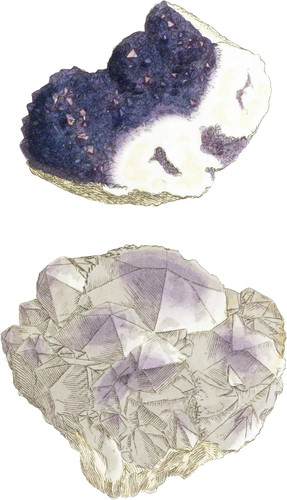 Enlarge
Enlarge
British Mineralogy
Coloured or Amethystine Quartz. Amethyst
- Div. 1. Crystallized.
Few would have thought that the Amethyst, so long well known as a precious stone, was Quartz or Rock-crystal coloured by Manganese.
It is occasionally found where other Quartz is found, but is more peculiar to some places. Those used by the lapidaries are generally from abroad, and are often brought in small polished pieces. Of ours, the upper specimen is from North Wales, and the lower one from Cornwall. Fine Quartz of any colour has always been esteemed and Used in jewellery, and its hardness makes it wear well. The yellow when set is often valued as Topaz; and although Topaz is hard enough to stratch it, yet, as it is not so fissile or so ready to split, may sometimes give it a superiority; and it is a free cutting stone to the lapidaries, being less liable to interrupt their operation and polishing, in which the grain, as they call it, must be attended to. I have before said that they are called St. David’s and St. Patrick’s, or Welsh and Irish Diamonds, and accordingly line ones have lately become as fashionable as the better Bristol stones used to be formerly; and they frequently say, as a proof of their near approach to Diamond, that they will cut glass like it, to enhance their value: but Quartz will only scratch glass, and will not produce a perfect separation in windows or plates of glass, like the Diamond. The colour of Amethystine Quartz is supposed to depend upon an Oxide of Manganese, as the yellow and ochraceous ones do upon Oxide of Iron.
Large and well-coloured specimens fetch a high price, even uncut and in their natural state, according to their richness and beauty.
Lord Compton found primitive Quartz, like tab. 41, in coloured Flint in a gravel pit near Cambridge, last year, (1810); and Miss Codrington, about the same time, at Eastbourne in Kent. Haüy, in his Tableau Comparatif, p. 152, says that it has been found in the environs of Liege in small crystals, occupying the cavities of Gray Quartz; probably like ours above-mentioned: but in April, this year, my persevering and kind friend W. Danby, esq. sent me a specimen in which the rhombs are relieved so as to show all sides, and are of the most transparent kind, perhaps unique. It is from Clifton Hill, near Bristol, where millions of specimens are gathered annually without finding such.

